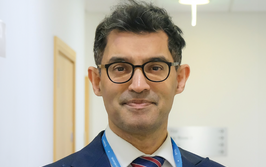
Error in the OR
Wrong eye surgery: how common is it, and can more be done to prevent it?
At a Glance
- Have you ever performed surgery on the wrong eye? If the answer is yes, you’re not alone – it’s estimated that around one in four ophthalmologists have
- Despite protocols aplenty to prevent it, wrong site surgery is among the most common errors that cause patient injury – and ophthalmology is one of the worst offenders
- Why? Increasing administrative tasks, unfamiliarity with the Universal Protocol, and the sheer volume of surgical procedures ophthalmologists perform are all possible factors
- Improved protocols and systems, and understanding and support for surgeons who encounter this issue, are needed to bring these numbers down and improve patient safety
The patient was a 20 year-old white male, with bilateral fourth nerve palsy, and significant incomitant left hypertropia. My plan was to perform a left inferior oblique recession and see how big an effect that had, and then possibly consider a second surgery.
Instead, I almost performed surgery on the right eye. After making the conjunctival incision, I realized that I made a mistake.
I felt guilty. But this experience also got me thinking: how common is wrong site surgery (WSS) in ophthalmology? What are the risk factors? And most importantly, is there more that I, or the profession as a whole, could be doing to prevent it?
When I researched WSS, I found some pretty big numbers. The Joint Commission on Accreditation of Healthcare Organizations has previously reported that WSS may be one of most common errors causing patient injury. – and it is estimated that it happens around 40 times a week in the US (1). But how common is it in ophthalmology? It’s speculated that around one in four ophthalmologists will make a WSS error, but I suspect the numbers may actually be even larger…
Avoiding autopilot
Back in 2004, the Universal Protocol was introduced to prevent wrong person, wrong procedure and wrong site surgery. This involves verifying you have the right patient, marking the surgical site, and letting everybody in the OR know exactly what the plan is (see Box 1).
How effective is this Universal Protocol? The short answer is, we have no idea. There has been no randomized controlled prospective study to evaluate the effect of the Universal Protocol on WSS. But one this is for sure – the numbers are increasing. There were 15 confirmed cases of WSS in the US back in 1998, in 2007 the number had gone up to 592, and it’s continuing to grow (2).
This increase could be caused by a number of factors. There’s a lot more transparency now, which is of course a good thing – nurses can report on your behalf, as can technicians. It could also be partly down to a false sense of security; “Well, we have a protocol in place now, so I must be doing surgery on the correct eye!” Or, it could actually be us, the ophthalmologists. Think about how you used to work 15 or even 10 years ago, and think about how you work now. As the surgeon, the burden on us is immense – we have to do so much more with so much less. We’re performing far more procedures. Think of the times when we’re busy wrangling with the electronic medical records system, before we even get a chance to speak properly with our patients. It’s ironic; we’re busy trying to fill out all the fields on our screen, and the patient is right there, yearning for our attention. So the very source of our job satisfaction, the thing that makes us feel happy and worthwhile, is disappearing and being replaced with a computer. The clinic is becoming more and more of an assembly line, and the patients, well, we know less and less about them. They’re becoming a big unknown.
The Universal Protocol
1. Systematic preoperative verification of the patient
- Verify the correct procedure, for the correct patient, at the correct site.
2. Marking the procedure site
- At a minimum, when there is more than one possible location for the procedure, mark the site.
3. Perform a timeout
- This should be done immediately before an incision is made.
- The procedure should not start until all questions or concerns are resolved.
We’re number one!
If you’ll forgive me for providing even more bad news – in 2009, the Veterans Health Administration Study named ophthalmology number one for the highest number of WSS cases (3).
Isn’t that incredible? Why is ophthalmology in particular so prone so this problem? Well, we’re doing far more cases than anyone else. Think about the indications for intravitreal anti-VEGF injections; for adults, it’s projected that US ophthalmologists will perform 5.9 million injections this year. As baby boomers age, the number requiring cataract surgery is increasing too.
My reading on this topic left me with possibly more questions than I had when I started. Why is WSS so common? What are the risk factors for it? What can we do to improve, and prevent WSS cases?
X marks the spot
To get some answers, I launched a survey in the summer of 2015. Along with colleagues, I sent emails to all the pediatric ophthalmologists on a 1,050 member-strong Internet listserv. Of the 156 surgeons who replied, over 40 percent had performed WSS (see Box 2).
I decided to analyze these two groups (those who had performed WSS, and those who hadn’t) and compare their practice patterns, to identify the risk factors for WSS. First, I looked at the different ways respondents marked the eye – some put initials by the eye they’re going to perform surgery on, some put a dot, a check, an X, or a line. Some people write down the muscles they’re going to perform surgery on, and in contrast, some people don’t mark the eye at all on a regular basis. We found that when any form of marking is performed (versus not marking the eye at all), the odds of WSS were 60 percent lower. Which indicates that the Universal Protocol, when followed, will reduce error.
Of 156 pediatric ophthalmologists surveyed:
- 36 performed one WSS
- 14 performed two WSSs
- 3 performed three WSSs
- 4 “almost” performed WSS - for example, they began the incision and the error was spotted before the surgery was completed
Secondly, I wanted to see who actually performed the timeout. In some places, it’s the surgeon who has to perform the timeout. In others, it’s the nurse who’s in charge, and in some places there’s no one officially in charge. We found the timeout also matters. When the surgeon performed it, the risk was reduced by a statistically significant amount. If the operating room/ theater nurse is in charge, or if multiple staff are involved (multiple implying no designated person in charge, and several people involved such as technicians, circulation nurses, residents, surgical assistants, etc.) the risk goes up.
I also looked at years in practice and WSS. Of the people who responded, the median for years in practice was around 15. Interestingly, surgeons with fewer than 15 years’ experience are less likely to perform WSS, compared to those with more. This might be explained by the fact that the longer we practice, the busier we get, and the more cases we handle. There could also be a cumulative effect as more cases are performed, and this appears to be a factor – the risk of WSS goes up with every year. There is also the possibility that people who have been practicing for a long time are just not familiar with the newer safety protocol. People who have greater experience may also feel more comfortable responding, and less afraid of being upfront about
their mistakes.
Lastly, there was no relationship found between the number of surgical sites we utilize (some of us operate in two, three or even four different sites), or the number of operating rooms used in one day. For example, some busy surgeons utilize two ORs a day, and move back and forth between them, but this was not associated with an increased risk of WSS.
Supporting and striving
It’s clear that WSS is not uncommon in our field. We all make mistakes, and none of us are perfect. For those who have performed WSS, it’s important for the rest of us to be supportive and understanding. For those of us who haven’t – be aware that your time may still come. As a profession, we need to strive towards better systems and protocols that work well for us, so that we can avoid these surgical surprises. And as our caseloads grow, and we experience other pressures, I think some simple advice could also help: slow down a little bit!
Donny Suh is Chief of Pediatric Ophthalmology and Strabismus at Truhlsen Eye Institute, Nebraska, US.
- The Joint Commission Center for Transforming Healthcare, “The wrong site surgery project”, (2011). Available at: bit.ly/2dg091m. Accessed September 20, 2016.
- DG Mulloy, RG Hughes, “Wrong-site surgery: a preventable medical error”, Patient safety and quality: an evidence-based handbook for nurses, chapter 36. Agency for Healthcare Research and Quality (US): 2008. PMID: 21328777.
- J Neily et al., “Incorrect surgical procedures within and outside of the operating room”, Arch Surg, 144, 1028–1034 (2009). PMID: 19917939.
Donny Suh is Chief of Pediatric Ophthalmology and Strabismus at Truhlsen Eye Institute, Nebraska, US.













